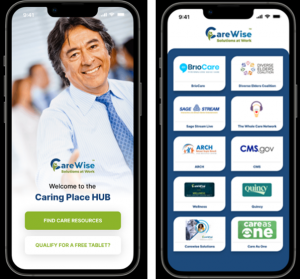
Power Dynamics Tilt from Traditional Employer Authority Patterns
Evolving expectations diverge from the past as employees now demand protection of their non-work lives.
Faulty assumptions
• The economics of healthcare-to-home shift the majority of the cost to the patient’s family and employers.
• The healthcare-to-home and community strategy depends on an informal workforce of uncompensated family caregiving worth $600 billion without typical business management structures.
• Family caregiving does not impact the workforce or people’s careers. Millennials are 25% of all caregivers at a time when they should be advancing their careers.
• Family members can provide care to aging loved ones at home, which evolves into nursing activities over ten hours a week and grows to 24/7.
Blurred boundaries between caring family roles and distributed healthcare-at-home –
Caregiving is such a throw-away term that the nation is confused about the critical elements:
• The aging baby boomer healthcare crisis.
• The quality of life of the entire family unit, including the family caregiver and the aging family member.
• The ability of businesses to maintain a sustainable workforce, especially considering the increased role of people of color and the disproportionately negative impact of caregiving on lower-wage employees.
Misaligned accountabilities and resources –
When baby boomers arrived without a home care system that fills the gap between the first awareness of our family’s extra support needs until our loved one enters a skilled care facility, the repercussions to the non-healthcare system are enormous.
Social and community service organizations are ill-equipped to provide adequate, timely, and connected resources to families.
Until our infrastructure improves, employers will bear the brunt of this caregiving crisis with an unstable, disengaged workforce for the next three decades as baby boomers age. Our aging population faces limited access to affordable long-term care, so in order to age at home, they rely on employed family. The healthcare system is actively deploying healthcare-to-home strategies that burden employed family members with an average of twenty hours a week of caregiving activities for five and a half years. This is physically, emotionally, and financially demanding, leading to stress, burnout, and negatively impacting work performance for caregivers. Those at home requiring care have diminished quality of life and greater concern as the lives of aging baby boomers are left in the hands of untrained, overworked, volunteer family caregivers.
Our healthcare system cannot solve the problem of family caregiving, especially as they actively promote the healthcare-to-home approach to delegate nursing duties to patients’ families. Families cannot solve the problem as they are overwhelmed daily by the collision of work and care. Employers are already paying the price for care-related waste. They are uniquely positioned to implement innovative strategies to support their workforce.
Employers Define the Root Cause of the Caregiving Crisis Workforce Problem
When employers survey staff, they discover how many valued staff are being redeployed (without choice) by the Care Economy. C-suite executives are family caregivers, too. So, they now see the need to accelerate the transition away from this caregiving crisis to support their own families and their team. An adequately resourced, healthy, high-performing, motivated, and caring management business system must be on the horizon.
Build a Performance and Reward System to Celebrate Transitional Progress
To reduce the impact of the escalating labor crisis, there is a growing recognition of the need to support workers caring for aging loved ones. Policies that provide family leave, flexible work arrangements, and increased access to affordable and quality long-term care are not enough to keep the workforce on the job. These policies force caregivers to leave their jobs for a day, a week, 12 weeks, or permanently. This approach destabilizes the workforce because the healthcare industry is ill-equipped to deal with the increasing medical needs of our aging population.
Our country is unprepared, even though the impact of aging baby boomers has been foreseeable for decades.
Deploy Innovative, Targeted, Turnkey Workforce Solutions
Until baby boomers stop requiring care or some radical transformation of the healthcare and social services network takes place, companies must change something. By deploying targeted turnkey organizational resources, Employees Exhausted by Caregiving receive support to stay on the job.
Every business can take a long-term approach to building a high-performing, motivated, and caring team.
• Bring employer and employee expectations together.
• Rebalance corporate ideology to protect all employees’ employment, careers, and health – especially the new majority caring for aging parents.
• Reskill the workforce to perform, considering major demographic changes caused by the aging baby boomer generation.
• Empower managers/team leaders to elevate awareness to assume greater responsibility around the conflicts of work and aging family caregiving.
• Invest in expanded Wellness, Work and Care education, professional resources and digital tools that acknowledge work and caregiving conflicts, normalize performance standards, and access resources to remediate individual and business losses.
The challenges of caregiving and employment touch every facet of our lives – our families, friends, neighbors, and colleagues. Employers must support caregiving families to build independence at home to maintain their jobs, income, and family relationships.
JEANNETTE GALVANEK
CAREWISE SOLUTIONS
jeannette@carewisesolutions.com
Conversations Around Aging Caregiving
EIN Presswire does not exercise editorial control over third-party content provided, uploaded, published, or distributed by users of EIN Presswire. We are a distributor, not a publisher, of 3rd party content. Such content may contain the views, opinions, statements, offers, and other material of the respective users, suppliers, participants, or authors.




